Monday 20th June 2022
Kern Laser Basics - Metal v Non Metal Cutting
Laser cutting is becoming an ever-popular
process within the manufacturing industry due to the low overhead and
processing versatility. Lasers can cut and mark wood, leather, fabric, plastic,
acrylic, metal, foam, and more. This wide range of processing materials makes
laser machines a great asset in many manufacturing facilities.
Laser systems: CO2 and fiber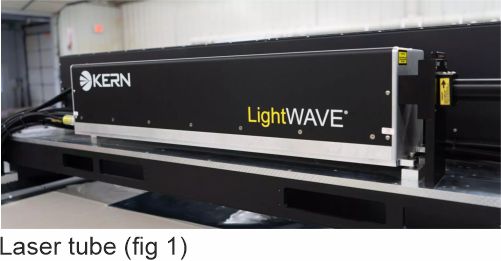 To discuss the
more in-depth differences between cutting metals versus non-metals, we must
first have a general understanding of laser systems. In general, there are two
types of lasers: CO2 —
by exciting the atoms of a gas mixture contained in a laser tube (usually made of glass, ceramic, or metal)
until the atoms create particles of light. This light is then bounced around in
the same chamber until an adequate amount of light (or wattage) is created then forced through a small apature . Fiber - uses fibre optical light which is passed through Ytterbium to create the energy. This beam of light is then directed out of the tube and into the optic
assembly, or head of the laser, where optics shape the beam and focus it directly
onto the material.
To discuss the
more in-depth differences between cutting metals versus non-metals, we must
first have a general understanding of laser systems. In general, there are two
types of lasers: CO2 —
by exciting the atoms of a gas mixture contained in a laser tube (usually made of glass, ceramic, or metal)
until the atoms create particles of light. This light is then bounced around in
the same chamber until an adequate amount of light (or wattage) is created then forced through a small apature . Fiber - uses fibre optical light which is passed through Ytterbium to create the energy. This beam of light is then directed out of the tube and into the optic
assembly, or head of the laser, where optics shape the beam and focus it directly
onto the material.
Fiber lasers
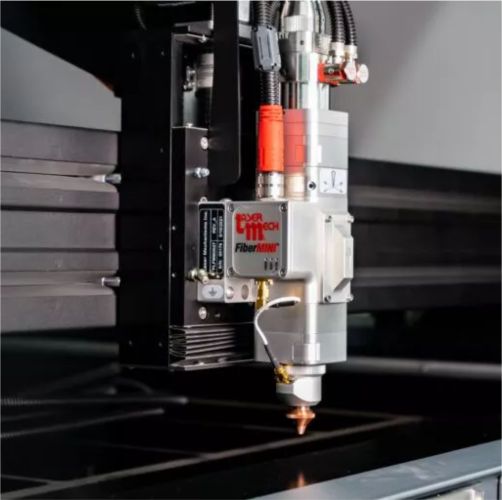 For fiber lasers, this beam travels along a cord of
fiber optic lines, like those used in fiber optic lights, that are
encased in rare-earth elements such as Ytterbium (most common), Thulium,
Holmium, Dysprosium, Erbium, and Neodymium. These encased fibers allow the beam
to travel from the origin point to the head of the laser while maintaining its
level of energy. The beam is then defined and shaped in the optic assembly via
lens before being focused into the material being processed. Fiber lasers are
generally high wattage — 500 watts and up — with some being over 20 kilowatts
(20,000 watts) and are typically used for high-production facilities dealing
with sheet metal. They are also the preferred laser option for thicker, highly
reflective metals such as copper or mirrored stainless steel.
For fiber lasers, this beam travels along a cord of
fiber optic lines, like those used in fiber optic lights, that are
encased in rare-earth elements such as Ytterbium (most common), Thulium,
Holmium, Dysprosium, Erbium, and Neodymium. These encased fibers allow the beam
to travel from the origin point to the head of the laser while maintaining its
level of energy. The beam is then defined and shaped in the optic assembly via
lens before being focused into the material being processed. Fiber lasers are
generally high wattage — 500 watts and up — with some being over 20 kilowatts
(20,000 watts) and are typically used for high-production facilities dealing
with sheet metal. They are also the preferred laser option for thicker, highly
reflective metals such as copper or mirrored stainless steel.
CO2 lasers
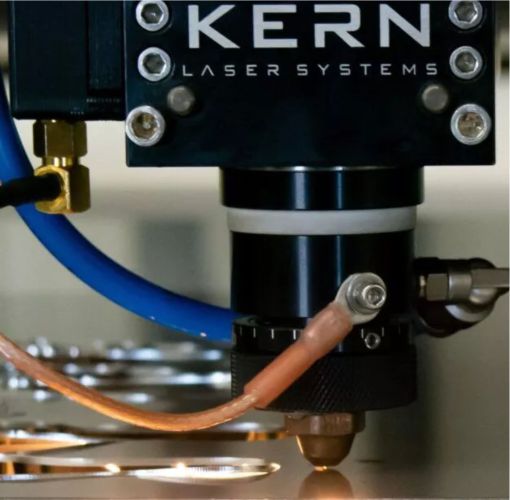 CO2 lasers, on the other hand, use mirrors to reflect the
beam created in the laser source instead of fiber optics. These mirrors not
only reflect the light back and forth throughout the tube of the laser source
but also direct the beam out of the tube and into the optic assembly. Once
directed into the optic assembly, the beam is focused through the lens and onto the material.
CO2 lasers, on the other hand, use mirrors to reflect the
beam created in the laser source instead of fiber optics. These mirrors not
only reflect the light back and forth throughout the tube of the laser source
but also direct the beam out of the tube and into the optic assembly. Once
directed into the optic assembly, the beam is focused through the lens and onto the material.
Metal vs. non-metal cutting
Moving
forward discussing metal cutting, the information applies to both fiber and CO2 lasers
— and non-metal cutting information refers only to CO2 lasers.
Laser head
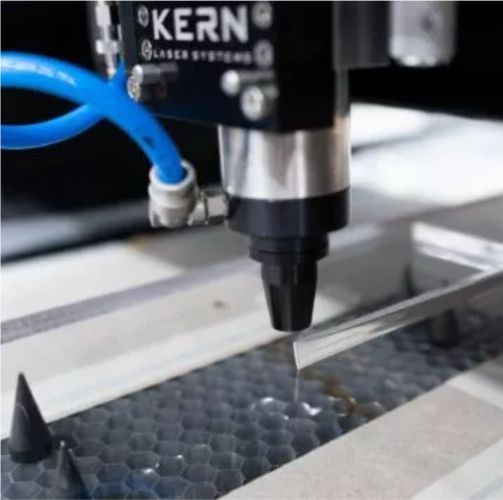 One of the main differences between these
two processes is the laser “head” or assembly, as shown in the images. A
dial allows for minute adjustments to the focus with the metal cutting
assembly. You may also have noticed that the nozzle on the metal assembly is
copper versus the aluminium nozzle of the non-metal cutting assembly. The
copper nozzle is used for an automatic height follower, which senses the
surface of any metal and continuously maintains the focus height over any
physical changes on the surface of the metal.
One of the main differences between these
two processes is the laser “head” or assembly, as shown in the images. A
dial allows for minute adjustments to the focus with the metal cutting
assembly. You may also have noticed that the nozzle on the metal assembly is
copper versus the aluminium nozzle of the non-metal cutting assembly. The
copper nozzle is used for an automatic height follower, which senses the
surface of any metal and continuously maintains the focus height over any
physical changes on the surface of the metal.
Alternatively, non-metal cutting does not yet have the capabilities for automatic focusing, so non-metal objects that are being processed need to be as flat as possible to maintain the focus height that is manually set by the operator. The differences in these nozzles also come into play when we talk about focus, which is another key factor.
Beam focus
Your beam focus
is another key difference in metal versus non-metal cutting. For non-metals,
your focus height is, in general, always the same distance that is measured
with a spacer that is 0.22” (5.5mm) thick — setting the tip of the cutting
assembly exactly 0.22” (5.5mm) away from the surface of the material. This allows for proper airflow and
ensures the material is being pierced and cut with the thinnest point of the
laser beam.
For metals, the
focus is a bit more complicated, as different metals require different focus
depths, but in general terms, your focus should be between 0.010″ (0.25mm) to
0.020″(0.5mm) from the surface of the material being processed — or about the
thickness of a gift card.
Settings
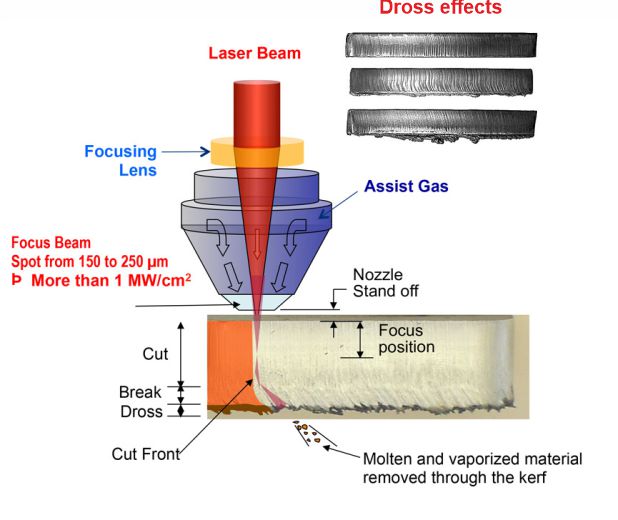 Metal cutting requires some additional
settings that non-metal cutting doesn’t need. These settings are “assist gas”
and “pierce.” To have a dross-free cut, metals require an assist gas of either
Nitrogen, Oxygen, or clean, dry shop air. This assist gas is blown through the
nozzle alongside the beam and into the cut, helping to keep debris away and
creating a clean, precise cut (fig 7)
Metal cutting requires some additional
settings that non-metal cutting doesn’t need. These settings are “assist gas”
and “pierce.” To have a dross-free cut, metals require an assist gas of either
Nitrogen, Oxygen, or clean, dry shop air. This assist gas is blown through the
nozzle alongside the beam and into the cut, helping to keep debris away and
creating a clean, precise cut (fig 7)
Your pierce settings are also an
incredibly important part of metal cutting, as the laser beam needs to pierce
the material before moving onto the cut. The pierce allows the beam to cleanly
cut through the dense (and potentially reflective) metal in a focused spot —
which means the rest of the cut is easier as the beam is already through the
material. Then it just continues to melt the material away as it moves through
the cut.
These settings are not necessary for
non-metals, but non-metals tend to need adjustments to the laser’s frequency to
help produce a clean cut.
The main
difference between metal and non-metal cutting is that metal cutting with a CO2 or fiber
laser requires a specific cutting head, a finer focus, and two additional
settings: pierce and assist gas.
We hope this article gives you some basic
insights into cutting metals versus non-metals with laser systems. Want to know more? Visit our Kern Laser Pages


 EUR (€)
EUR (€)


